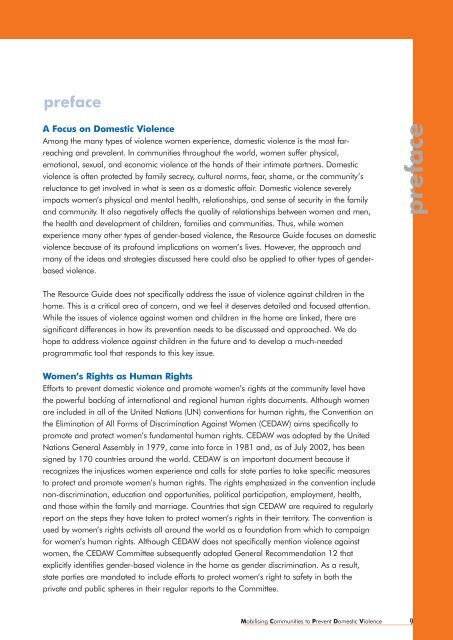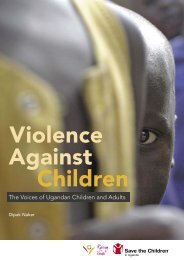Mobilising Communities to Prevent - Raising Voices
Mobilising Communities to Prevent - Raising Voices
Mobilising Communities to Prevent - Raising Voices
- No tags were found...
Create successful ePaper yourself
Turn your PDF publications into a flip-book with our unique Google optimized e-Paper software.
preface<br />
A Focus on Domestic Violence<br />
Among the many types of violence women experience, domestic violence is the most farreaching<br />
and prevalent. In communities throughout the world, women suffer physical,<br />
emotional, sexual, and economic violence at the hands of their intimate partners. Domestic<br />
violence is often protected by family secrecy, cultural norms, fear, shame, or the community’s<br />
reluctance <strong>to</strong> get involved in what is seen as a domestic affair. Domestic violence severely<br />
impacts women’s physical and mental health, relationships, and sense of security in the family<br />
and community. It also negatively affects the quality of relationships between women and men,<br />
the health and development of children, families and communities. Thus, while women<br />
experience many other types of gender-based violence, the Resource Guide focuses on domestic<br />
violence because of its profound implications on women’s lives. However, the approach and<br />
many of the ideas and strategies discussed here could also be applied <strong>to</strong> other types of genderbased<br />
violence.<br />
preface<br />
The Resource Guide does not specifically address the issue of violence against children in the<br />
home. This is a critical area of concern, and we feel it deserves detailed and focused attention.<br />
While the issues of violence against women and children in the home are linked, there are<br />
significant differences in how its prevention needs <strong>to</strong> be discussed and approached. We do<br />
hope <strong>to</strong> address violence against children in the future and <strong>to</strong> develop a much-needed<br />
programmatic <strong>to</strong>ol that responds <strong>to</strong> this key issue.<br />
Women’s Rights as Human Rights<br />
Efforts <strong>to</strong> prevent domestic violence and promote women’s rights at the community level have<br />
the powerful backing of international and regional human rights documents. Although women<br />
are included in all of the United Nations (UN) conventions for human rights, the Convention on<br />
the Elimination of All Forms of Discrimination Against Women (CEDAW) aims specifically <strong>to</strong><br />
promote and protect women’s fundamental human rights. CEDAW was adopted by the United<br />
Nations General Assembly in 1979, came in<strong>to</strong> force in 1981 and, as of July 2002, has been<br />
signed by 170 countries around the world. CEDAW is an important document because it<br />
recognizes the injustices women experience and calls for state parties <strong>to</strong> take specific measures<br />
<strong>to</strong> protect and promote women’s human rights. The rights emphasized in the convention include<br />
non-discrimination, education and opportunities, political participation, employment, health,<br />
and those within the family and marriage. Countries that sign CEDAW are required <strong>to</strong> regularly<br />
report on the steps they have taken <strong>to</strong> protect women’s rights in their terri<strong>to</strong>ry. The convention is<br />
used by women’s rights activists all around the world as a foundation from which <strong>to</strong> campaign<br />
for women’s human rights. Although CEDAW does not specifically mention violence against<br />
women, the CEDAW Committee subsequently adopted General Recommendation 12 that<br />
explicitly identifies gender-based violence in the home as gender discrimination. As a result,<br />
state parties are mandated <strong>to</strong> include efforts <strong>to</strong> protect women’s right <strong>to</strong> safety in both the<br />
private and public spheres in their regular reports <strong>to</strong> the Committee.<br />
<strong>Mobilising</strong> <strong>Communities</strong> <strong>to</strong> <strong>Prevent</strong> Domestic Violence<br />
9
















